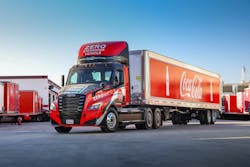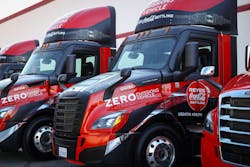Reyes Coca-Cola adds 20 eCascadias to California fleet
Coca-Cola is getting greener out West. Daimler Truck North America delivered 20 zero-emission, battery-electric Class 8 Freightliner eCascadia tractors to Reyes Coca-Cola Bottling, a West Coast and Midwest bottler and distributor of Coca-Cola brands.
These electric vehicles will join RCCB's fleet of delivery trucks in Downey, California, and represent the first zero-emission heavy-duty tractors added to its California fleet. RCCB is part of Reyes Holdings, which ranks No. 35 on the FleetOwner 500: Private and is the seventh largest food product private fleet in the U.S.
The RCCB's acquisition of the electric trucks comes months before the first California clean fleet regulations—the most rigid emissions rules in the U.S.—begin to take effect for Golden State fleets.
See also: 'So here we are': Truckers debate a post-gas-tax future
The fleet's new eCascadias will rely on 20 Detroit eFill commercial chargers at the Downey facility. The fleet also uses the Detroit Charger Management System. This software solution provides fleet managers with a view of their electric vehicles and energy management designed to reduce operational costs.
"We're excited to roll out these 100% electric, zero-emission heavy-duty tractors as we strive toward our goal of reducing our carbon emissions in our operations by 30% by 2030," said Tim Heinen, VP of strategic infrastructure and development at RCCB. "Our electric fleet for Downey, which now includes electric semi-trucks and electric customer care vehicles, will serve customers throughout Southern California and build on our commitment to make a positive difference in our communities."
The fleet worked with Detroit eConsulting, a team of eMobility experts who help fleets plan electrification strategies, including site design and EV integration. According to DTNA estimates, the 20 eCascadias are expected to cut the fleet's diesel consumption by 40,000 gallons per year.
"Our collaboration with Reyes Coca-Cola Bottling marks a significant milestone in promoting sustainable transportation," said David Carson, SVP of sales and marketing at DTNA. "The integration of Freightliner eCascadias into RCCB's fleet showcases that business and environmental responsibility can go hand-in-hand, all while fostering innovation and efficiency."
According to DTNA, the eCascadias can reach an 80% charge in 2.5 to 3 hours. The OEM offers the tractors with various battery and drive axle options, providing a range of 155, 220, or 230 miles, depending on the setup.
The multiple configurations offered are ideal for short and regional haul routes involving depot-based charging, including last-mile logistics, local and regional distribution, drayage, and warehouse-to-warehouse operations.
Depots with fewer trucks can be more easily electrified right now, according to the NACFE Run On Less Electric—Depot study that concluded this fall. "For those small energy depots, we're saying, 'Act now, go,'" Mike Roeth, NACFE executive director, told FleetOwner this month. "As for the large energy depots—and we're skipping over mediums stuck between small and large—but at the large energy depots, the trucks are getting more range. The Tesla Semi taught us that these trucks could do 400, 500 miles."
Several depots NACFE studied during its latest three-week Run On Less included fleets using Freightliner eCascadias. The industry nonprofit made the data on all vehicles in the study public online.
However, running 50 or more heavy-duty EVs at larger depots is becoming "more possible," Roeth explained. But the electric grid is a hurdle. At one of the larger depots NACFE studied, the fleet used up to 10 megawatts—enough energy to power 10,000 homes daily.
About the Author
Josh Fisher
Editor-in-Chief
Editor-in-Chief Josh Fisher has been with FleetOwner since 2017. He covers everything from modern fleet management to operational efficiency, artificial intelligence, autonomous trucking, alternative fuels and powertrains, regulations, and emerging transportation technology. Based in Maryland, he writes the Lane Shift Ahead column about the changing North American transportation landscape.



